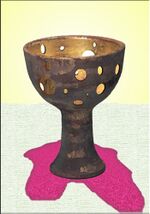Knights Templar

The Knights Templar was the paramilitary wing of the medieval Catholic Church. It achieved a teutonic shift in the annals of fabled legendary orders, thus leading to the Teutonic Knights.
On the way up[edit]
The order of Knights Templar was founded in 1119 in Jerusalem when French knights, under the influence of Champagne, vowed to protect Christian pilgrims in the Holy Land. This was perhaps the greatest folly until Barack Obama would turn the tables and go to bat for Muslims who had snuck into the United States.
The Knights Templar were originally restricted to spoiled noblemen who pledged to observe a vow of poverty and obedience; that is, to liars. However, the order was promptly opened to liars in lower stations in life, and it grew by leaps and bounds. King Baldwin II gave the Knights Templar office space in his palace in Jerusalem, though it was cramped, the lighting wasn't good, and the WiFi kept cutting out.
Despite these obstacles, the Knights Templar eventually agreed on a uniform of white robes with red crosses, which no one has ever thought of since; and agreed to divide its membership into four classes (knights, sergeants, farmers, and chaplains), whose influence is seen in every modern deck of playing cards.
The pope provided protection for the Knights Templar, and they played an important role in the Crusades, with roughly 20,000 of them dying in battle. While they were laying down their lives, other Knights were snapping up key properties all over Europe, and opening banks.
On the way down[edit]
It is said that "pride cometh before a fall," but flashing fat bankrolls and buying drinks for everyone at the bar often cometh even sooner. The ruling princes of Europe began to envy the sawbucks the Knights Templar were frittering around. King Philip "The Fair" of France investigated the order, throwing all the French Knights Templar in prison and torturing them, but only until they agreed they had been committing blasphemy all along. Nothing could be fairer.
Jacques de Molay, the leader of the group, later said that he had been lying when he confessed, but he was burned at the stake, so it does not matter. He gave his name to the Order of De Molay, a Masonic youth group in America, although this group's ritual hazing of new inductees stops short of burning them at the stake.
Knights Templar in other countries were also put on trial, but were not tortured and did not confess. A new pope abolished the order in 1312, a new King of France got all their cash, and their office in the Jerusalem palace is now back to serving as the linen closet.
What's this about a Grail?[edit]
Speculation has always arisen regarding the Knights' early occupation of the Temple Mount in Jerusalem, and the possibility that members may have absconded with some precious relics, say, a Holy Grail here, or maybe an Ark of the Coverlet there. Surely the Knights did possess some relics; they did not snap up all those Alpine properties merely on good looks. And many churches still display the bones of a saint, a scrap of cloth once worn by a holy man, or a condom once used by an honest man. The Knights were said to own a piece of the True Cross, which the Bishop of Acre carried into battle at the Horns of Hattin, the Cross bringing him no more luck than it did its original bearer. Saladin captured the relic, which the Bishop obviously had no more use for, and ransomed it back to the Crusaders in 1191.
The Templars supposedly also owned the head of Saint Euphemia, and during the Inquisition, several Knights were asked about a secret collection of not only heads but tails. There was supposed to be a cat, a bearded head, an Anus, or a certain "Baphomet." But modern scholars believe this last is just a French misspelling of Muhammad, which the French usually can't do without funny accents over the vowels, and the Knights didn't have him either.
The Holy Grail was associated with the Knights Templar even back in 1180, in the fiction of the time. Later, Sir Galahad was depicted dressed like a Knight, and the Holy Grail became an English legend. Why, it could have been the shiny Grail, excavated beneath Jerusalem, that was screwing up wireless reception in the Knights' first headquarters. The Knights would have possessed it and kept it secret for generations despite acquiring and then losing most of Europe's finest hiding places. But throughout the Inquisition, there was no mention of a Grail, nor any evidence that the Knights offered anything for all those properties except more mundane trinkets and confusing time-share agreements. Most mainstream scholars agree that the connection to the Grail is just a fiction, not unlike those that they peddle to us in the guise of Climate Science.
Jesus and Mary Gang[edit]
The Templars are said to have kept a big book of secrets about the true fate of Jesus and Mary Magdalene. This was lost for centuries until Dan Brown discovered it in a bin outside the Grand Masonic Lodge in London. It listed all Jesus's aliases and that Mary was the mother of a family of long-haired layabouts who eventually became Kings of the Franks. What it didn't say was where all the gold had gone.
Knights of the Bath[edit]
Nor did it say where all the deodorant had gone, but in 1725, King George followed his nose and issued a Ban on the Templars. In their place, he created the Knights of the Bath. These comprised the king, a grand master, and 36 night bachelors seeking night companions.
Their name is taken from the traditional ceremonial bath, a ritual that often occurs in an unceremonious city of the same name in Royal Bathshire. It is the next higher order after the Knights of the Manicure.
The British ruler confers this form of knighthood on artists, scholars, and other of his cronies. It entitles the recipient to use the term "Sir" before his name, though Uncyclopedia does too, and with much less rigamarole.
Knights Templar, the sequel[edit]
In a seemingly unrelated development in 1972, a crack commando unit of Knights Templar was sentenced by a military court for a crime they didn't commit. These men promptly escaped from a maximum-security stockade into the Los Angeles underground. Today, still wanted by the government, they survive as soldiers of fortune. If you have a problem, if no one else can help, and if you can find them, maybe you can hire the Knights Templar.
| |||||||||||||



